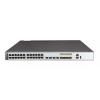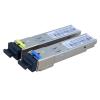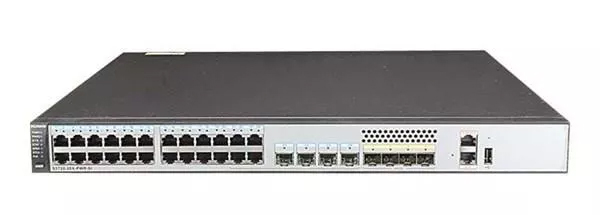-
zł

Huawei S5720-28P-SI-AC to zarządzalny switch (przełącznik) wyposażony w 20 gigabitowych portów Ethernet, 4 porty Combo (Gigabit Ethernet / SFP) i 4 sloty SFP (1 Gb/s). Wydajność przełączania urządzenia wynosi 336 Gb/s, a prędkość przekazywania pakietów 42 Mp/s. Obudowa została przystosowana do montażu w szafie Rack 19", switch doskonale sprawdzi się w wielu sieciach, zapewnia zaawansowane funkcje zarządzania Layer 3.
Oferowany produkt wspiera OSPF, IS-IS, BGP i VRRP. Obsługuje protokoły IPv4 i IPv6, w tym IPv4 unicast routing oraz multicast routing (PIM-DM, PIM-SM, IGMP, MSDP, RPF). Oprócz tego zapewnia również pełne wsparcie multicast Layer 2, VLANów (w tym również QinQ) oraz odpowiedni poziom zabezpieczeń. S5720-52X-PWR-SI-AC wykorzystuje technologię iStack, dzięki której możliwa jest wirtualizacja wielu switchy w jeden, co upraszcza konfigurację i zarządzanie. Urządzenie wspiera również technologię SVF (Super Virtual Fabric) umożliwiającą wirtualizację sieci switchy rdzeniowych / agregacyjnych, dostępowych i punktów dostępu do jednego elementu sieci w celu uproszczenia i utrzymania (O&M) sieci.
Switch wyposażony jest w jeden zasilacz AC 150 W, istnieje możliwość dołożenia drugiego zasilacza (posiada 2 miejsca).
Najważniejsze cechy:
- 20 gigabitowych portów Ethernet (10/100/1000 Mb/s);
- 4 porty Combo (Gigabit Ethernet / SFP);
- 4 sloty SFP (1 Gb/s);
- wydajność przełączania 336 Gb/s;
- prędkość przekazywania pakietów 42 Mp/s;
- zarządzanie Layer 3 (m. in. OSPF, IS-IS, BGP, VRRP, PIM-DM, PIM-SM);
- wsparcie iStack oraz SVF;
- w zestawie znajduje się jeden zasilacz AC.
Specyfikacja:
| S5720-28P-SI-AC | |
| Porty | |
|---|---|
| Porty GE |
20 gigabitowych portów Ethernet 10/100/1000 Mb/s
4 porty Combo (Gigabit Ethernet / SFP) 1 Gb/s
4 sloty SFP 1 Gb/s |
| Porty 10G | Brak |
| Porty zarządzania | |
| ETH | Tak |
| Konsola (RJ45) | Tak |
| USB | USB 2.0 |
| Procesor | |
| Taktowanie | 800 MHz |
| Ilość rdzeni | 2 |
| Pamięć | |
| Pamięć RAM | 512 MB |
| Pamięć flash | 512 MB, w tym 240 MB dostępne dla użytkowników |
| Zasilanie | |
| Rodzaj zasilacza | 150 W AC hot-plug |
| Redundancja |
1+1 (drugi zasilacz jest opcjonalny, nie ma go w zestawie) |
| Rekomendowany zakres napięcia |
100 - 240 V AC 50/60 Hz |
| Maksymalny zakres napięcia |
90 - 264 V AC 47 - 63 Hz |
| Maksymalny prąd wejściowy | 3 A |
| Maksymalny pobór mocy |
34,6 W |
| Pobór mocy przy obciążeniu 30% | 21,2 W |
| Chłodzenie | |
| Sposób chłodzenia | Aktywne |
| Ilość wentylatorów | 1 |
| Przepływ powietrza | Od lewej do prawej strony |
| Wydzielanie ciepła |
118 BTU/h |
| Właściwości fizyczne | |
| Wymiary | 442 x 420 x 44.4 mm |
| Wysokość | 1 U |
| Waga | 9,1 kg |
| Właściwości środowiskowe | |
|
Dopuszczalna temperatura pracy (długoterminowa) |
0 - 1800 m: 0°C - 45°C
1800 - 5000 m: Zakres temperatury spada o 1°C na każde 220 m |
|
Dopuszczalna temperatura pracy (krótkoterminowa) |
0 - 1800 m: -5°C - 50°C
1800 - 5000 m Zakres temperatury spada o 1°C na każde 220 m |
| Dopuszczalna temperatura przechowywania | -40°C - 70°C |
| Dopuszczalna wilgotność powietrza | 5%-95% niekondensująca |
| Głośność przy normalnej temperaturze | 52 dB(A) |
| Głośność przy wysokiej temperaturze | 73.8 dB(A) |
| Ciśnienie akustyczne przy normalnej temperaturze | 38.7 dB(A) |
| Ochrona przepięciowa portów Ethernet | ±6 kV |
| MTBF | 85.48 lat |
| Oprogramowanie | |
| Ethernet | |
| Podstawowe funkcje Ethernet |
Full-duplex, halfduplex, and autonegotiation Rate autonegotiation on an interface Flow control on an interface Jumbo frames Link aggregation Load balancing among links of a trunk Transparent transmission of Layer 2 protocol packets Device Link Detection Protocol (DLDP) Link Layer Discovery Protocol (LLDP) Link Layer Discovery Protocol-Media Endpoint Discovery Interface isolation Broadcast traffic suppression on an interface Multicast traffic suppression on an interface Unknown unicast traffic suppression on an interface VLAN broadcast traffic suppression VLAN multicast traffic suppression VLAN unknown unicast traffic suppression |
| VLAN |
VLAN: 4094 VLANIF: 1024 Access mode Trunk mode Hybrid mode QinQ mode Default VLAN VLAN assignment based on interfaces VLAN assignment based on protocols VLAN assignment based on IP subnets VLAN assignment based on MAC addresses VLAN assignment based on MAC address + IP address VLAN assignment based on MAC address + IP address + interface number Adding double VLAN VLAN mapping Selective QinQ MUX VLAN Voice VLAN Guest VLAN |
| GVRP |
GARP GVRP |
| VCMP | VCMP |
| MAC |
MAC address 16K Automatic learning of MAC addresses Automatic aging of MAC addresses Static, dynamic, and blackhole MAC address entries Interface-based MAC address learning limiting Sticky MAC MAC address MAC address Port bridge |
| ARP |
Static ARP Dynamic ARP ARP entry: 4K ARP aging detection Intra-VLAN proxy ARP Routed proxy ARP |
| Ethernet loop protection | |
| MSTP |
STP RSTP MSTP VBST BPDU protection Root protection Loop protection Defense against TC BPDU attacks |
| Loopback detection | Loop detection on an interface |
| SEP | SEP |
| Smart Link |
Smart Link Smart Link multiinstance Monitor Link |
| RRPP |
RRPP Single RRPP ring Tangent RRPP ring Intersecting RRPP ring Hybrid networking of RRPP rings and other ring networks |
| ERPS |
G.8032 v1 G.8032 v2 ERPS semi-ring topology ERPS closed-ring topology |
| IPv4/IPv6 forwarding | |
| IPv4 and unicast routing |
IPv4 static routing VRF DHCP client DHCP server DHCP relay Routing policies IPv4 routes: 8K RIPv1 RIPv2 OSPF Policy-based routing (PBR) |
| Multicast routing features |
IGMPv1/v2/v3 PIM-DM PIM-SM MSDP IPv4 multicast routes: 1K IPv6 multicast routes: 1L Multicast routing policies RPF |
| IPv6 features |
IPv6 protocol stack ND ND entry: 2K ND snooping DHCPv6 snooping RIPng DHCPv6 server DHCPv6 relay OSPFv3 IPv6 routes VRRP6 MLDv1/v2 PIM-DM for IPv6 PIM-SM for IPv6 |
| Layer 2 multicast | |
| Layer 2 multicast features |
IGMPv1/v2/v3 snooping IGMP snooping proxy MLD snooping Multicast traffic suppression Inter-VLAN multicast replication |
| Device reliability | |
| Stacking |
Service interfacebased stacking Maximum number of stacked devices: 9 Stack bandwidth (Unidirectional): Up to 48 Gbit/s |
| VRRP | VRRP standard protocol |
| Ethernet OAM | |
| EFM (802.3ah) |
Automatic discovery of links Link fault detection Link troubleshooting Remote loopback |
| CFM (802.1ag) |
Software-level CCM 802.1ag MAC ping 802.1ag MAC trace |
| OAM association | Association between 802.1ag and 802.3ah |
| Y.1731 |
Unidirectional delay and jitter measurement Bidirectional delay and jitter measurement |
| Właściwości QoS | |
| Traffic classification |
Traffic classification based on ACLs Configuring traffic classification priorities Matching the simple domains of packets |
| Traffic behavior |
Traffic filtering Traffic policing (CAR) Modifying the packet priorities Modifying the simple domains of packets Modifying the packet VLANs |
| Traffic shaping |
Traffic shaping on an egress interface Traffic shaping on queues on an interface |
| Congestion avoidance | Tail drop |
| Congestion management |
Priority Queuing (PQ) Weighted Deficit Round Robin (WDRR) PQ+WDRR Weighted Round Robin (WRR) PQ+WRR |
| ACL | |
| Packet filtering at Layer 2 to Layer 4 |
Number of rules per IPv4 ACL: 2K Number of rules per IPv6 ACL: 2K Basic IPv4 ACL Advanced IPv4 ACL Basic IPv6 ACL Advanced IPv6 AC Layer 2 ACL User-defined ACL |
| Konfiguracja | |
| Login and configuration management |
Command line interface (CLI)-based configuration Console terminal service Telnet terminal service SSH v1.5 SSH v2.0 SNMP-based NMS for unified configuration Web page-based configuration and management EasyDeploy (client) SVF Cloud management OPS |
| File system |
Directory and file management File upload and download |
| Monitoring and maintenance |
eMDI Hardware monitoring Log information output Alarm information output Debugging information output Port mirroring Flow mirroring Remote mirroring Energy saving |
| Version upgrade |
Version upgrade Version rollback |
| Zabezpieczenia | |
| ARP security |
ARP packet rate limiting ARP anti-spoofing Association between ARP and STP Dynamic ARP Inspection (DAI) Static ARP Inspection (SAI) Egress ARP Inspection (EAI) |
| IP security |
ICMP attack defense IPSG for IPv4 IPSG user capacity IPSG for IPv6 IPSGv6 user capacity |
| Local attack defense | CPU attack defense |
| MFF | MFF |
| DHCP snooping |
DHCP snooping Option 82 function Dynamic rate limiting for DHCP packets |
| Attack defense |
Defense against malformed packet attacks Defense against UDP flood attacks Defense against TCP SYN flood attacks Defense against ICMP flood attacks Defense against packet fragment attacks Local URPF |
| Kontrola dostępu i uwierzytelnianie | |
| AAA |
Local authentication Local authorization RADIUS authentication RADIUS authorization RADIUS accounting HWTACACS authentication HWTACACS authorization HWTACACS accounting |
| NAC |
802.1X authentication MAC address authentication Portal authentication Hybrid authentication |
| MACSec | MACSec |
| Policy association | Functioning as the access device |
| Pozostałe funkcje | |
| Network management |
Ping Tracert NQA NTP sFlow SNMP v1 SNMP v2c SNMP v3 HTTP HTTPS NETCONF/YANG RMON |
| Interoperability |
VLAN-based Spanning Tree (VBST) Link-type Negotiation Protocol (LNP) VLAN Central Management Protocol (VCMP) |






 Polski
Polski English
English Italiano
Italiano Español
Español Čeština
Čeština Српски
Српски Deutsch
Deutsch Ελληνικά
Ελληνικά Slovenský
Slovenský





